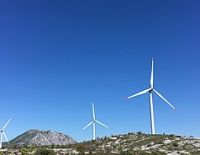Oregon has very high onshore wind potential measured in tens of thousands of MW.
Offshore (floating) wind represents a significant future opportunity, but development will depend on overcoming environmental, regulatory, and community hurdles.
With the RPS and continued investment, wind (especially in combination with storage) is likely to play an increasingly important role in Oregon’s clean energy future.
Interesting Facts & Current Numbers
- Installed Capacity
- As of the 2024 Biennial Energy Report, Oregon has ~3,981 MW of utility-scale wind facilities in operation.
- According to WINDExchange, earlier data listed 2,843 MW, but capacity has grown.
- Generation
- In 2022, Oregon generated around 8.2 million MWh from wind.
- A significant portion is exported – about 45% of wind generation in 2022 went out of state.
- In some previous years (e.g., 2020), even 57% of wind generation was exported.
- Share in Electricity Mix
- Wind is a meaningful part of Oregon’s generation mix: historically around 10–12% of in-state electricity generation has come from wind.
- In 2016, wind was the third largest electricity resource in the state.
- Major Wind Projects
- Shepherds Flat Wind Farm: Very large facility (~845 MW) in eastern Oregon (Gilliam & Morrow counties).
- Klondike III Wind Project: ~300 MW capacity.
- Golden Hills Wind Project: ~200 MW in Sherman County.
- Vansycle Wind Project: One of the earlier wind farms in Oregon.
- Wheatridge Renewable Energy Facility: Combines 300 MW wind + 50 MW solar + 30 MW battery storage.
- Policy & Goals
- Oregon has a Renewable Portfolio Standard (RPS): among large utilities, the target is 50% renewable energy by 2040.
- There are two floating offshore wind lease areas designated off the Oregon coast (~195,000 acres total), with potential for ~2.4 GW capacity.
- However, there is local opposition: some companies have backed away due to concerns from tribal groups, fishermen, and coastal residents.
- Challenges & Considerations
- A lot of wind generation is exported, which means while Oregon produces a lot of wind power, not all of it is used in-state.
- Wind output can fluctuate significantly (weather-dependent), which is why hybrid projects (like wind + solar + storage) are becoming more attractive.
- Siting and environmental concerns exist, especially for offshore wind.
